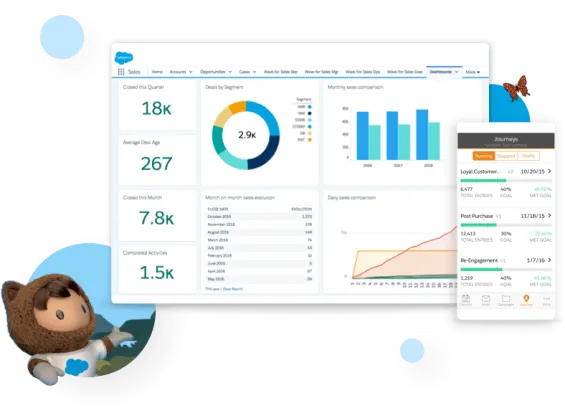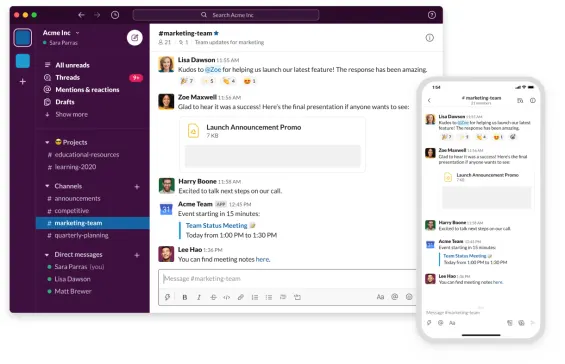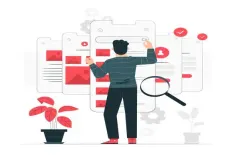This topic will be discussed with the following structure.
- Relevance of SaaS in Development
- Is it worth developing SaaS in 2023?
- Examples of SaaS-based Apps
- Important Aspects of SaaS-based Design
- Advantages of Creating a SaaS Application
- The Process of Development
- The Challenges During the Development
- How SaaS Applications are Changing Conditions in the Development Market
- Conclusion
Software as a Service (SaaS) has become a widespread concept in the field of app development. Users that utilize SaaS can access software online without having to install and maintain it on their own hardware.
SaaS has established itself as a significant alternative for app development, given the ongoing rise of cloud computing and the increased demand for adaptable and scalable software solutions. But the question still stands:
In this article, we will consider the relevance of SaaS apps development, examples, SaaS application design as well as the process of development.
Relevance of SaaS in Development
SaaS is significant in the creation of apps. It offers a variety of advantages that make it a desirable choice for both users and developers.

These benefits include:
- cost savings because customers don't have to buy and maintain pricey software licenses as they just pay for the services they utilize
- flexibility and scalability, allowing users to easily add or remove features in accordance with their needs
- a higher level of security because the provider hosts and maintains the software
SaaS offers a number of other benefits in addition to these, including increased collaboration and communication, easier access to updates and upgrades, and more accessibility across various devices and platforms. These benefits show that SaaS will continue to play a big role in app development for years to come.
Is it worth developing SaaS in 2023?
Without any doubt, it will be well worth it to create SaaS in 2023. It is anticipated that as enterprises and individuals look for more adaptable and scalable software solutions, demand for SaaS solutions will rise.

In accordance with this trend, a MarketsandMarkets analysis predicts the SaaS market will grow to $1,240.9 billion by 2027.
Examples of SaaS-based Apps
There are numerous examples of SaaS-based apps that have been successful in recent years.
Salesforce: A typical instance is a cloud-based customer relationship management (CRM) platform, which allows companies to manage their sales, marketing, and customer service operations from one platform.

Source: https://www.salesforce.com/au/...
Slack: Team communication platform that allows users to collaborate and communicate in real-time.

Source: https://slack.com/features
There are a number of other popular SaaS-based programs available, including Dropbox, Zoom, Hubspot, Shopify, and several more. These applications have established successful and scalable software solutions that meet their users' needs by utilizing the advantages of SaaS.
Important Aspects of SaaS-based Design
When designing a SaaS-based app, there are several important aspects to consider:
Firstly, scalability and flexibility must be prioritized because these are core SaaS benefits. This demands that the app be built in a way that enables the simple addition or removal of functionality and supports a growing user base.

Second, security must be given top priority because users will be depending on the provider to keep their data secure. To ensure that user data is always protected, this calls for the deployment of strong security mechanisms like encryption and multifactor authentication.
Finally, it's critical to prioritize usability and accessibility because these aspects greatly increase user adoption of a SaaS application design. This requires creating a simple user experience for the app and making sure it works well on a variety of platforms and devices.
Advantages of Creating a SaaS Application
The way we use software has changed as a result of Software as a Service (SaaS). SaaS enables customers to access software via the Internet rather than purchasing and installing it on individual devices, making it a flexible and affordable solution for enterprises.

The following are some of the main advantages of developing a SaaS application:
Scalability: Scalability is one of the many important advantages of SaaS. As the number of users increases, the system can be readily scaled to accommodate more. This suggests that companies can easily grow their operations without worrying about the cost and difficulty of modernizing their IT infrastructure.
Lower costs: Businesses no longer need to spend money on pricey software licensing or expensive IT infrastructure to support the product thanks to SaaS. Instead, customers can use the Internet to access the program and just pay for the services they need. SaaS is therefore a very affordable business solution, especially for small and medium-sized firms.
Flexible payment models: SaaS apps typically offer a variety of payment methods, including tiered pricing, monthly or yearly subscriptions, and pay-per-use. Businesses can choose the payment option that best suits their needs and financial resources thanks to this degree of flexibility.
Accessibility: SaaS is accessible from any device with an Internet connection, which is one of its main benefits. Because users may access the program from any location at any time, it is a very practical and adaptable corporate solution that fosters cooperation and productivity.
Easy updates and maintenance: With SaaS, software updates and maintenance are handled by the provider, meaning that businesses do not need to worry about upgrading their software or maintaining their IT infrastructure. This makes it a highly convenient solution for businesses, freeing up time and resources that can be focused on other important tasks.
Improved security: SaaS providers are typically responsible for maintaining the security of their software and infrastructure, meaning that businesses can benefit from the latest security measures without having to invest in costly security solutions themselves. This makes SaaS a highly secure solution for businesses, reducing the risk of data breaches and other security threats.
The Process of Development
A well-planned and performed development process is crucial for producing a successful SaaS application. The key stages in creating a SaaS application are as follows:
Ideation
The first stage in developing a well-thought-out and properly built SaaS application is determining the issue that the SaaS service will address. This entails developing a thorough understanding of the target market and the requirements of potential customers. The application development team can start coming up with ideas for the app once the issue has been identified.
Requirements gathering
In order to create a SaaS application, the next step is to identify the essential requirements. For determining the features and functionalities that the application should have, this requires communicating with potential users, stakeholders, and other relevant groups. Along with these considerations, the development team must also think about scalability, security, and user-friendliness.
Design and architecture
The development team can begin the SaaS application design process after gathering the requirements. The team develops wireframes and mockups at this stage to reflect the user interface and user experience of the program visually. The development team must also specify the architecture of the program, which includes the technological stack, database design, and APIs.
Development
The development team can start creating the application after the design and architecture are complete. This entails creating the application's front-end and back-end, connecting APIs, and performing extensive testing to find and correct any faults and issues.
Deployment and testing
After the application has been created, it must be transferred to a testing environment so that the development team can evaluate it in a real-world setting and spot any problems that need to be fixed before the application is made available to the public.
Launch and maintenance
The application can be made available to the wider public following successful testing. To find areas for improvement, it is essential to keep checking the program for problems and faults and gathering feedback from users. To maintain the program up-to-date and helpful, the development team should continue to provide new features and functionalities.
The Challenges During the Development
Developing a SaaS app can be difficult for a number of reasons, from technical to commercial.

The following are some typical issues that developers could run into when creating a SaaS application:
Scalability: One of the main advantages of SaaS is scalability, as was previously mentioned. It can, however, be difficult to develop. Developers must make sure the program can readily scale up to manage a huge user base and significant data in order to avoid sacrificing performance or security.
Security: Given that SaaS apps hold sensitive customer data in the cloud, security is an important concern. As a result, developers must incorporate suitable safeguards like encryption, access control, and backups into the architecture and infrastructure of the application.
Data migration: It can be challenging and time-consuming to move data from an existing on-premises solution to a SaaS service. Developers must ensure that the data is moved accurately, securely, and without losing any data or functionality.
Integration with other systems: To achieve a seamless integration that doesn't affect the security or functionality of the application, SaaS applications must be integrated with other systems, such as CRM or ERP software, with careful planning and implementation.
User adoption: The success of SaaS apps depends on the approval of users, therefore SaaS application design is crucial. Developers must create intuitive and user-friendly interfaces and user experiences while offering users the necessary training and support to ensure high user adoption rates and success rate of SaaS application design.
Business model and pricing: The SaaS application's pricing strategy and business model must be considered by developers. This entails selecting the best pricing structure, such as tier pricing, pay-per-use, or monthly or yearly subscriptions. Pricing must be competitive, provide customers with value, and support business profitability.
How SaaS Applications are Changing Conditions in the Development Market
In many respects, SaaS apps have reshaped the development industry.

The development market is being impacted by SaaS applications in the ways listed below:
Shift towards cloud-based solutions: A move towards cloud-based solutions has been brought on by the introduction of SaaS applications. As a result of its greater adaptability, scalability, and cost-effectiveness, cloud-based solutions are becoming more and more popular among businesses as opposed to on-premise software.
Increased demand for specialized skills: Cloud computing, data management, and API integration expertise are necessary for the development of SaaS applications. Due to the increasing demand for developers with these skills the demand for specialized knowledge in the development field has changed.
Greater focus on user experience: SaaS application design is made with the end-user experience in mind, with the goal of offering a seamless and user-friendly interface. The importance of creating user-friendly and appealing SaaS application designs has increased in the development market as a result of this focus on the user experience.
Shift towards subscription-based pricing models: SaaS apps' subscription-based pricing models have given companies a more stable source of income. As a result, more companies in the development industry are implementing subscription-based pricing models that favor monthly or yearly subscriptions over one-time purchases.
Increased competition: The introduction of SaaS apps has made the development industry more competitive. As more companies provide cloud-based solutions, developers must work harder to set their products apart from the competition and give customers more for their money.
Conclusion
SaaS apps have caused a paradigm change in the development area and provide both businesses and their clients with a number of benefits. They have shifted the emphasis to cloud-based solutions, increased the demand for specialized skills, and given user experience greater weight.
SaaS applications have also encouraged market competition and led the transition to subscription-based pricing models.
Despite the difficulties involved in creating SaaS applications, such as security, scalability and user-friendly SaaS application design, the benefits they provide make them a desirable choice for companies seeking flexibility, scalability, and cost-efficiency.
In order to remain competitive and provide value to their customers, developers must adjust to these changes and stay informed about the most recent trends and technology.
Read Next
The following articles are related to rise of saas apps: revolutionizing the development market.









